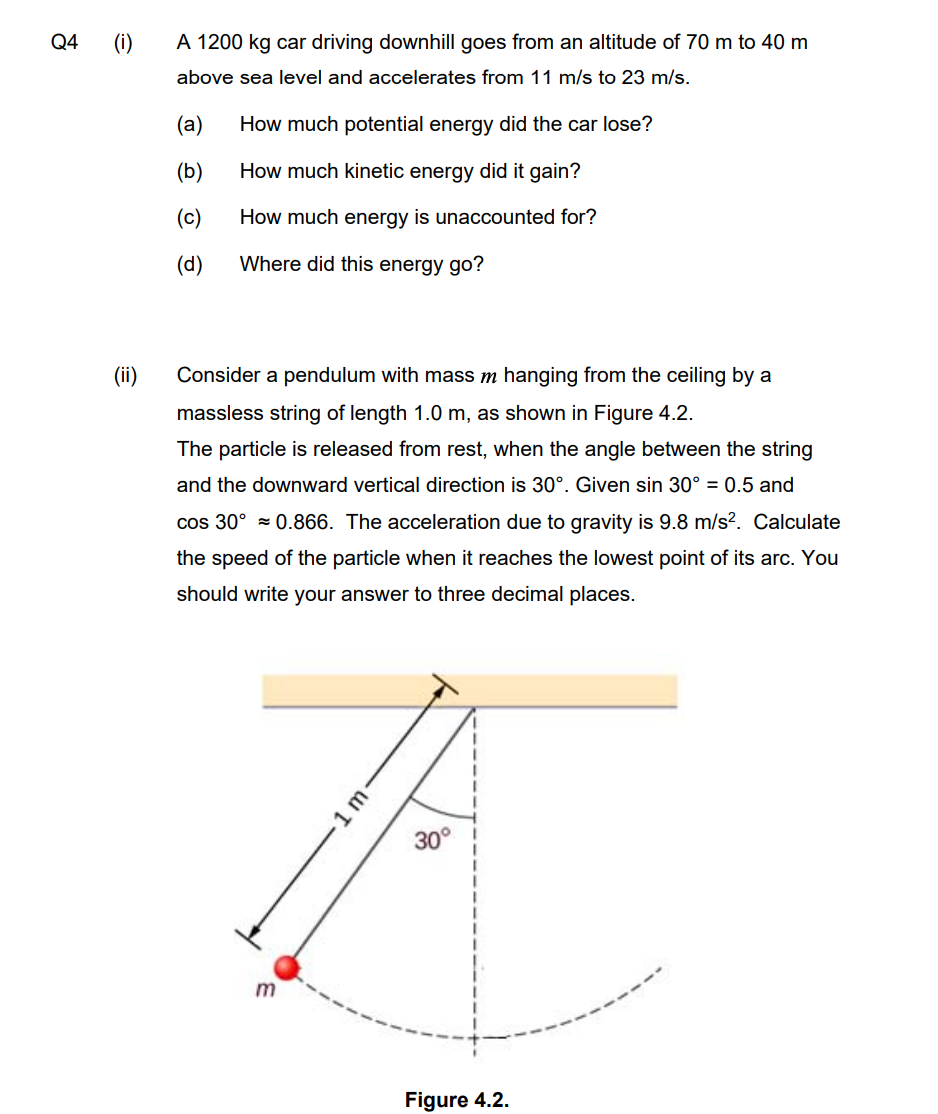Q4 (i) A 1200 kg car driving downhill goes from an altitude of 70 m to 40 m above sea level and accelerates from 11 m/s to 23 m/s. (a) How much potential energy did the car lose? (b) How much kinetic energy did it gain? (c) How much energy is unaccounted for? (d) Where did this energy go? (ii) Consider a pendulum with mass m hanging from the ceiling by a massless string of length 1.0 m, as shown in Figure 4.2. The particle is released from rest, when the angle between the string and the downward vertical direction is 30°. Given sin 30° = 0.5 and cos 30° = 0.866. The acceleration due to gravity is 9.8 m/s?. Calculate the speed of the particle when it reaches the lowest point of its arc. You should write your answer to three decimal places. 30° Figure 4.2
Q4 (i) A 1200 kg car driving downhill goes from an altitude of 70 m to 40 m above sea level and accelerates from 11 m/s to 23 m/s. (a) How much potential energy did the car lose? (b) How much kinetic energy did it gain? (c) How much energy is unaccounted for? (d) Where did this energy go? (ii) Consider a pendulum with mass m hanging from the ceiling by a massless string of length 1.0 m, as shown in Figure 4.2. The particle is released from rest, when the angle between the string and the downward vertical direction is 30°. Given sin 30° = 0.5 and cos 30° = 0.866. The acceleration due to gravity is 9.8 m/s?. Calculate the speed of the particle when it reaches the lowest point of its arc. You should write your answer to three decimal places. 30° Figure 4.2
Elements Of Electromagnetics
7th Edition
ISBN:9780190698614
Author:Sadiku, Matthew N. O.
Publisher:Sadiku, Matthew N. O.
ChapterMA: Math Assessment
Section: Chapter Questions
Problem 1.1MA
Related questions
Question
100%
hi, can you help me with all parts of this question.
thank you

Transcribed Image Text:Q4
(i)
A 1200 kg car driving downhill goes from an altitude of 70 m to 40 m
above sea level and accelerates from 11 m/s to 23 m/s.
(а)
How much potential energy did the car lose?
(b)
How much kinetic energy did it gain?
(c)
How much energy is unaccounted for?
(d)
Where did this energy go?
(ii)
Consider a pendulum with mass m hanging from the ceiling by a
massless string of length 1.0 m, as shown in Figure 4.2.
The particle is released from rest, when the angle between the string
and the downward vertical direction is 30°. Given sin 30° = 0.5 and
cos 30° = 0.866. The acceleration due to gravity is 9.8 m/s?. Calculate
the speed of the particle when it reaches the lowest point of its arc. You
should write your answer to three decimal places.
30°
Figure 4.2.
Expert Solution
This question has been solved!
Explore an expertly crafted, step-by-step solution for a thorough understanding of key concepts.
This is a popular solution!
Trending now
This is a popular solution!
Step by step
Solved in 5 steps with 3 images

Knowledge Booster
Learn more about
Need a deep-dive on the concept behind this application? Look no further. Learn more about this topic, mechanical-engineering and related others by exploring similar questions and additional content below.Recommended textbooks for you

Elements Of Electromagnetics
Mechanical Engineering
ISBN:
9780190698614
Author:
Sadiku, Matthew N. O.
Publisher:
Oxford University Press

Mechanics of Materials (10th Edition)
Mechanical Engineering
ISBN:
9780134319650
Author:
Russell C. Hibbeler
Publisher:
PEARSON

Thermodynamics: An Engineering Approach
Mechanical Engineering
ISBN:
9781259822674
Author:
Yunus A. Cengel Dr., Michael A. Boles
Publisher:
McGraw-Hill Education

Elements Of Electromagnetics
Mechanical Engineering
ISBN:
9780190698614
Author:
Sadiku, Matthew N. O.
Publisher:
Oxford University Press

Mechanics of Materials (10th Edition)
Mechanical Engineering
ISBN:
9780134319650
Author:
Russell C. Hibbeler
Publisher:
PEARSON

Thermodynamics: An Engineering Approach
Mechanical Engineering
ISBN:
9781259822674
Author:
Yunus A. Cengel Dr., Michael A. Boles
Publisher:
McGraw-Hill Education

Control Systems Engineering
Mechanical Engineering
ISBN:
9781118170519
Author:
Norman S. Nise
Publisher:
WILEY

Mechanics of Materials (MindTap Course List)
Mechanical Engineering
ISBN:
9781337093347
Author:
Barry J. Goodno, James M. Gere
Publisher:
Cengage Learning

Engineering Mechanics: Statics
Mechanical Engineering
ISBN:
9781118807330
Author:
James L. Meriam, L. G. Kraige, J. N. Bolton
Publisher:
WILEY